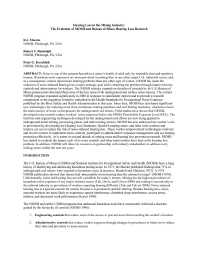Mining Publication: Hearing Loss in the Mining Industry: The Evolution of NIOSH and Bureau of Mines Hearing Loss Research
Original creation date: January 2010
Noise is one of the greatest hazards to a miner’s health, rivaled only by respirable dust and repetitive trauma. Hazardous noise exposures are more prevalent in mining than in any other major U.S. industrial sector, and, as a consequence, miners report more hearing problems than any other type of worker. NIOSH has made the reduction of noise-induced hearing loss a major strategic goal and is attacking the problem through improved noise controls and interventions for workers. The NIOSH strategy expands on decades of research by its U.S. Bureau of Mines predecessors that identified some of the key issues with underground and surface noise sources. The current NIOSH program expanded significantly in 2000 in response to stakeholder interest and to provide a research complement to the regulatory initiative embodied in the Health Standards for Occupational Noise Exposure published by the Mine Safety and Health Administration in that year. Since then, NIOSH has developed significant new technologies for reducing noise from continuous mining machines and roof bolting machines, which have been the main sources of noise overexposures for underground coal miners. Field studies have shown that NIOSH-developed noise controls reduce workers’ noise exposures below the MSHA Permissible Exposure Level (PEL). The facilities and engineering techniques developed for the underground coal efforts are now being applied to underground metal mining, processing plants, and other mining sectors. NIOSH has also addressed the worker’s role in prevention by developing the Hearing Loss Simulator, QuickFit earplug tester, and other tools workers and trainers can use to reduce the risk of noise-induced hearing loss. These worker-empowerment technologies motivate and involve miners to implement noise controls, participate in administrative exposure management, and use hearing protection effectively. As it enters its second decade of mining noise and hearing loss prevention research, NIOSH has started to evaluate the impact each of its noise controls and other interventions have had on the hearing loss problem. In addition, NIOSH will direct its resources in partnership with industry stakeholders to address every mining sector within the next ten years.
Authors: RJ Matetic, RF Randolph, PG Kovalchik
Book Chapter - January 2010
NIOSHTIC2 Number: 20036586
Extracting the Science: A Century of Mining Research. Brune JF, ed., Littleton, CO: Society of Mining, Metallurgy, and Exploration, 2010 Jan; :23-29
See Also
- Administrative Controls for Reducing Worker Noise Exposures
- Application of Phased Array Technology for Identification of Low Frequency Noise Sources
- Cross-Sectional Survey of Noise Exposure in the Mining Industry
- Determining Underground Roof Bolting Machine Operators Noise Exposure Using Laboratory Results
- Hearing Loss Prevention in Mining - 2005
- Hearing Loss Prevention Overview
- Noise Control in Underground Metal Mining
- Noise Exposure in Longwall Mining and Engineering Controls Research
- A Technique for Estimating the Sound Power Level Radiated by Pneumatic Rock Drills and the Evaluation of a CSIR Prototype Rock Drill with Engineering Noise Controls
- Underground Evaluation of Coated Flight Bars for a Continuous Mining Machine
- Water Well Safety Bits: Health And Safety Information For The Water Well Industry
- Page last reviewed: 9/21/2012
- Page last updated: 9/21/2012
- Content source: National Institute for Occupational Safety and Health, Mining Program


 ShareCompartir
ShareCompartir
